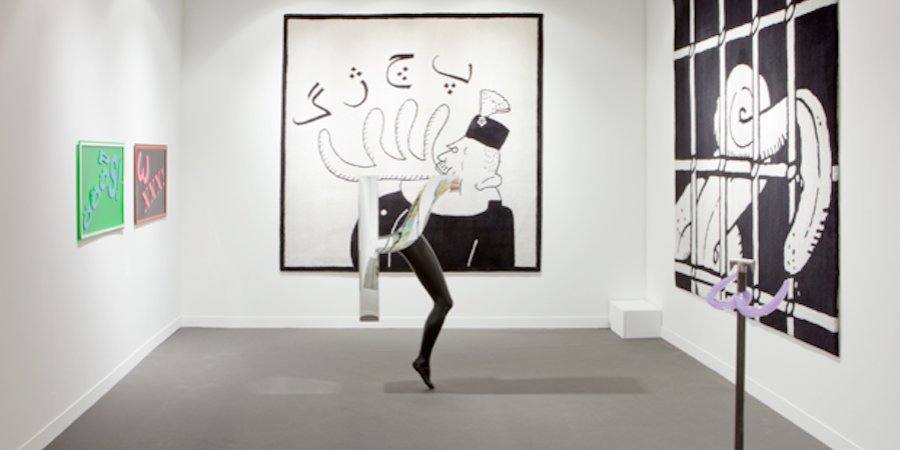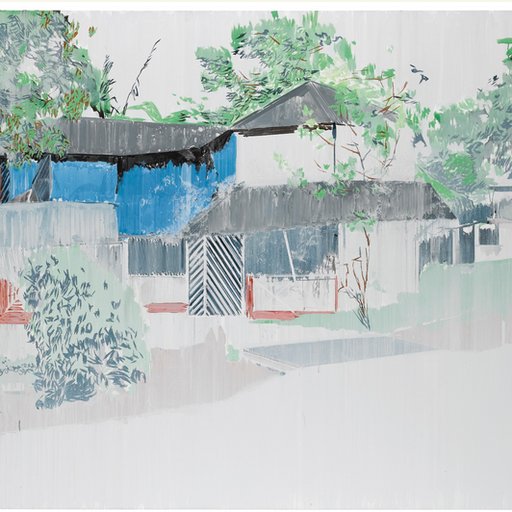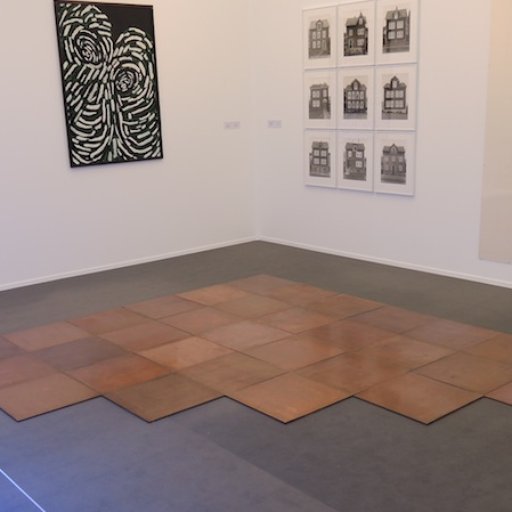Paris during the week of this year's FIAC art fair, for me, was about art that needs to be experienced in person—like the immersive environments of French relational aestheticians Pierre Huyghe (at the Centre Pompidou) and Philippe Parreno (at the Palais de Tokyo)—and about being welcomed into people’s homes rather than restaurants, a deeply personal form of socializing that helps you connect with the city much more. Here is my diary of what I saw and what I did over the course of the fair.
DAY ONE — WEDNESDAY, OCTOBER 23
FIAC threw open its doors at 10 a.m. on a very bright and clear day, with the sun shining through the glass rooftop of Paris's Grand Palais onto the fair below, giving the vernissage the air of a blessed event. Too blessed, perhaps: everyone was forced to don sunglasses inside, though dealers opted to squint instead so as not to look like they partied too hard the night before.
Simon Lee Gallery’s booth was abuzz with interest for Jeff Elrod following the abstract painter's successful and oversubscribed solo show in London, which in turn followed his well-received exhibition at MoMA PS1 earlier this year. A newcomer to the gallery's program also drew attention: David Ostrowski, another abstractionist who will soon have a solo show at the gallery. Having studied with Albert Oehlen, the artist has been influenced by Elrod as well as Christopher Wool.
I also enjoyed Richard Aldrich’s works at Bortolami, where I chatted with Art Basel director Marc Spiegler and art advisor Meredith Darrow. Other notable displays included a solo booth presentation of new work by Slavs and Tatars at Berlin's Kraupa-Tuskany Ziedler—an installation with the tongue-in-cheek title Long-Legged Linguistics. It as recently announced that the art duo, who gained wider visibility in the United States last winter when they had a solo show at MoMA, will receive another survey at Kunsthalle Zurich next summer.
To celebrate FIAC's opening, I then went to lunch at L’Avenue with my core art-world crew: collector Abdullah AlTurki, ArtBinder founder Alex Chemla, and curator Elise Van Middelem, the last of whom recently got off the 21-day journey on Doug Aitken's "Station to Station" train and was telling us all about the amazing experience, which she organized.
The evening was full of dinners. I opted for the intimate one that my dear Paris friends Christophe Boutin and Mélanie Scarciglia were hosting for Slavs and Tatars at the gallery and office of Onestar Press, their printmaking shop that happens to be an esteemed Artspace partner. For the occasion, they produced a Slavs and Tatars edition of a mirror work based on a book they published together a few years earlier called Changed Names—it was gorgeous. As for dinner itself, it was a home-cooked meal that felt steeped in domestic warmth, with guests serving ourselves delicious lentil soup and a fresh salad of oranges and shaved carrots. There I chatted with Antonia Carver, the director of Art Dubai, about her fair's upcoming focus on the Caucuses for its next edition, which is being curated by Slavs and Tatars.
After dinner, I went for drinks at the home of Patricia Marshall, an annual bash that the art advisor throws in her gorgeous apartment overlooking the Eiffel Tower. Every year, Patricia rehangs her collection, and this year the star of the show was David Ostrowski, whose gorgeous abstract painting hung in the living room. Other works on display were by her collection's standbys, like Nate Lowman and Dan Colen. It was such a pleasant evening – all the windows and balconies of Paricia’s corner apartment were open, letting in the unusually warm Parisian evening air.
After the party, many people opted going to David Lynch's nightclub Silencio, where Ryan Trecatrin and Lizzie Fitch were DJing, but I chose to go to sleep and rest up for a full museum day.
DAY TWO — THURSDAY, OCTOBER 24
I had an ambitious agenda filled with shows I wanted to see across the city, but I was in luck: my friend the art advisor Alex Marshall, Patricia’s son, has a FIAT 500, so we took that to visit galleries and museums all day.
We started with Pierre Huyghe exhibition at the Centre Pompidou, where we spent an hour and a half. It was an incredible show, one that needs to be experienced first-hand and cannot be easily relayed into words. For starters, certain elements of it are “alive” and change haphazardly, so each viewer experiences the shows differently. To further complicate the installation, the show was curated in the galleries that previously held the Mike Kelley show that has since traveled to MoMA PS1—and instead of hiding this fact, Pierre decided to embrace it, partly out of budgetary constraints, partly as an artistic gesture. So here and there the labels describing Kelley’s works have remained visible on the walls.
As for Huyghe's contributions themselves, at the entrance he scratched into part of the wall's sheetrock to expose layers of green color, showing the “'life’ of the walls as if the museum were a living tree. Another work in that first room involved a colony of ants moving on the wall, and a spider living in the corner. This work recalls an 2011 show Pierre did at his Berlin gallery, Esther Schipper Gallery, that was called "Influants" and featured living spiders, the living ants, and a receptionist who was injected with the flu.
We had the pleasure of walking around the exhibition with Esther Schipper's Florian Ludde, who filled us in on many of the unusual details. He also brought us to see a selection of Pierre's onetime dOCUMENTA contributions, including a sculpture with a beehive on its head (I steered clear of the bees) and a video featuring a dog with a pink leg. Once I walked away from the video, I thought I was hallucinating—but no, the actual dog really did run past me. It's part of the exhibition! The dog lives there, walks around, and hangs out with visitors, but doesn't allow them to touch her. The only person who can pet her is her owner—the guy who tended the garden Pierre created for dOCUMENTA.
One other highlight of the show included a “smoke and ice and water” machine, which producing these three things interchangeably. It was an amazing exhibition, surreal to its core in that it truly transported you into another, magical world.
From there, we walked to my favorite falafel place in the Jewish quarter of the Marais, where I used to live. At my secret restaurant, called Chez Marianne, we ran into Venice Biennale and New Museum curator Massimiliano Gioni and his wife, High Line curator Cecilia Alemani—so I guess it's not so secret after all. It was nice to see Massimiliano, who I will see again next month when I co-host the "Next Generation" dinner at the New Museum on November 20th.
After lunch, we went to Campoli Presti gallery, where I went to view a piece by Daniel Lefcourt, who I'm really into right now. I also loved the Liz Deschenes show on view, which is the sister show one currently up in London. Liz really pushes the boundaries of photography. Then it was off to see Philippe Pareno's show at the Palais de Tokyo.
So, Philippe and Pierre are old friends and collaborators, and its very interesting that they have two major exhibitions up in Paris at the same time. But my personal experience of the show was colored by the knowledge that Philippe is severely ill, which forced me to experience the survey as a whole in a totally different way—as if this, tragically, could be his last gesture, and therefore needs to be grand.
Just like with Pierre's exhibition, Philippe's show cannot be readily described but needs to be experienced—a point Philippe drove home by offering every visitor a DVD with their ticket that can only be viewed once and then self-destructs. For the installation, Philippe invited many artists to contribute their collaborations: Dominique Gonzales-Forrester created a “library,” which twisted around like a bookcase in an old home and revealed a secret hidden exhibition room filled with John Cage and Merce Cunningham drawings. New drawings are added every day, and by the end of the show the room will be completely filled with them.
There was also a gallery of unrealized projects, with the light turning on and off. When light is on, the glow-in-the-dark ink on colored sheets of paper “recharged” the unrealized projects drawings—then the light would go dark and the viewer could see the drawings, but only for some time, until they faded into darkness and the light turned on again.
I also loved the Ann Lee project that Pierre Huyghe and Philippe Parreno originally conceived but then gave to Tino Seghal—I was able to interact with the little girl doing the performance, in which she pretends to be a manga character who has come to life and is quizzical about the way humans behave. She asked me in French, “Do you like to be too busy or not busy enough?” and I said, “Too busy.” She asked why and someone behind me answered, “Because she is afraid of the void.” At the culmination of the show, there was a downstairs room of Philippe’s light pieces, all choreographed to turn on and off in a concert-like formation.
That evening I went to a cocktail soirée at Cindy Sherman's home, which was so beautiful and sweet. I love seeing people’s homes, and Cindy is a past master at buying things at flea markets and other offbeat places. I then went to art dealer Patrick Seguin’s home for a luxurious buffet dinner that he hosted in honor of the opening of his new "Calder/Prouvé" show in his gallery. Wow, was his home incredible—it made me feel like a barbarian with no taste. Jean Prouvé and Jean Royère furniture was coupled with works by Liz Deschenes, Nate Lowman, Dan Colen, Adam McEwen, Richard Prince, and Jean-Michel Basquiat, whose drawings on display were just stunning. Patrick took me, Nate, and Meredith Darrow to see his bungalow, which featured a re-assembled masterwork by Le Corbusier.
After this was another night at Silencio and a Gavin Brown's Enterprise party, both of which I skipped in favor of going home.
LAST DAY — SATURDAY, OCTOBER 26
After spending the Friday of FIAC dashing across the city (as best one can "dash" in Paris)—from a cozy cocktail at the home of Kreo Gallery's Clemence and Dider Krzentowski, to catch the launch of Nate Lowman's new collaboration with Converse (he uses the Marilyn Monroe image he lifted from de Kooning's 1954 painting to make 21 unique shoes), and finally a Lanvin "evening picnic" thrown in the beautiful courtyard of the Ecole National Superieure des Beaux-Arts de Paris, where I chatted with hosts Amalia Dayan and designer Alber Elbaz—it was a wonder I managed to get up at all Saturday morning.
Still, I was determined to attend the early-a.m. announcement of the winner for this year's Prix Marcel Duchamp, an annual award that recognizes a promising young talent with a solo project in the Centre Pompidou. (This year's was by 2012 laureates, the cerebral sculptors Dewar & Gicquel.) Ever since 2010, when Cyprien Gaillard won the prize, I have made it a habit of staying behind in Paris so I can celebrate with the winner at the prize's sweeping award dinner, given at the old-world-glamorous Hotel Dassault.
This year, it was tricky to know who to root for, as three of the four nominees—Latifa Echakhch, Claire Fontaine, and Raphael Zarka—had been included in "Perpetual Battles," an exhibition we put together for Baibakov Art Projects in 2010. (The exhibition also included past winners Thomas Hirschhorn, Saâdane Afif, and Gaillard.) Still, I was particularly thrilled to hear when the committee announced that the 2013 winner would be Latifa.
I fell in love with her work in 2009 while we were doing research for the exhibition. There was just something about her economic but very elegant use of materials, such as in Fantasia, a set of empty black flag poles she showed with us in Moscow, or Stoning, an installation created using stones that the artist had pilfered herself from the Russian railroads. (Yes, she did get caught by a surly engineer, but she managed to talk her way out of it, leaving her a great "when in Russia" anecdote—and us a stunning piece.)
Over dinner at Dassault, I thought about what an honor it was to be able to celebrate the accomplishments of the four nominated artists. But even more than that, the evening was a reminder that, as other fairs start to feel the same, FIAC will always have something distinctly Parisian to set it apart. À la prochaine fois!
The strategic director of Artspace, Maria Baibakova is also an accomplished collector and the founder of Moscow's Baibakov Art Projects.



























